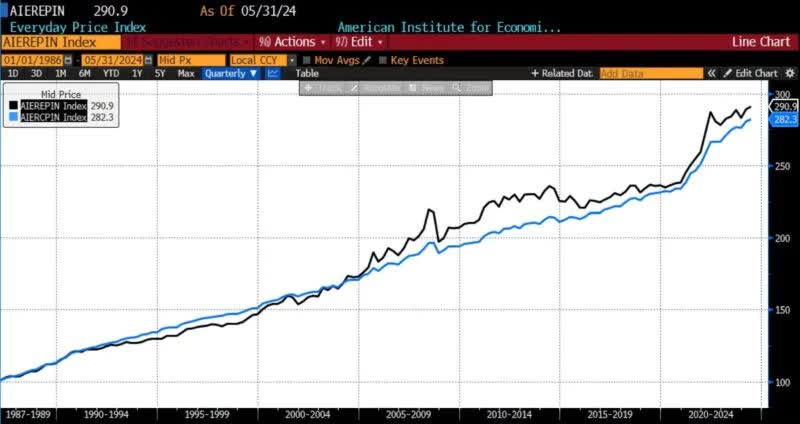By Peter C. Earle
In May 2024, the AIER Everyday Price Index (EPI) was essentially unchanged at an index level of 290.9. This was the smallest monthly increase in the index since June 2023 and also the first time since December 2023 in which core month-over-month CPI rose more than the EPI.
AIER Everyday Price Index vs. US Consumer Price Index (NSA, 1987 = 100)
(Source: Bloomberg Finance, LP)
In May 2024, the largest monthly price increases among EPI constituents were seen in food away from home, prescription drugs, and tobacco/smoking products, with the largest declines in admission to movies, theaters, and concerts, motor fuel, and cable, satellite, and live-streaming services. Among the 24 index constituents, 12 rose in price, two were unchanged, and 10 fell.
On June 12, 2024, the US Bureau of Labor Statistics (BLS) released Consumer Price Index (CPI) data for May 2024. The month-to-month headline CPI number was unchanged (0.0 percent), exceeding survey expectations of a 0.1 percent gain. The core month-to-month CPI number increased by 0.2 percent, less than the 0.3 percent forecasted.
Within the month-over-month headline CPI in May, the food index was up 0.1 percent, with the food away from home index rising by 0.4 percent. The food at home index remained unchanged. The energy index saw a 2.0 percent decrease during the month, driven primarily by a 3.6 percent drop in the gasoline index. In the core CPI on a month-to-month basis, the medical care index increased by 0.5 percent, with prescription drugs rising 2.1 percent and hospital services up 0.5 percent. Physician services remained unchanged. The used cars and trucks index rose 0.6 percent after a 1.4 percent drop in April. Education increased by 0.4 percent. Airline fares fell by 3.6 percent, new vehicles declined by 0.5 percent, communication, and recreation indexes decreased by 0.3 percent and 0.2 percent, respectively, while prices for apparel, household furnishings, motor vehicle insurance, and personal care also saw declines.
May 2024 US CPI headline and core month-over-month (2014 – present)
(Source: Bloomberg Finance, LP)
From May 2023 to May 2024, headline CPI rose 3.3 percent, less than the expected 3.4 percent. Year-over-year core CPI rose 3.4 percent, which was also less than the survey prediction of 3.5 percent.
May 2024 US CPI headline & core year-over-year (2014 – present)
From May 2023 to May 2024 within the headline CPI, the food at home index increased by 1 percent, with meats, poultry, fish, and eggs rising 2.4 percent, and nonalcoholic beverages up 1.3 percent. Fruits and vegetables saw a 0.6 percent increase, cereals and bakery products rose by 0.7 percent, and dairy products fell by 1.0 percent. The food away from home index rose 4 percent, with limited service and full service meals up 4.5 and 3.5 percent respectively. The energy index increased by 3.7 percent with gasoline up 2.2 percent, electricity up 5.9 percent, natural gas up 0.2 percent, and fuel oil up 3.6 percent.
In year-over-year core CPI during that same period, the shelter index rose by 5.4 percent, continuing to contribute significantly to the increase in all items less food and energy index. Notable annual increases as of May 2024 included a 20.3-percent gain in motor vehicle insurance, a 3.1-percent increase in medical care, and a 2.9-percent rise in personal care.
The recent data, combined with the deceleration in core CPI in April, suggests the resumption of disinflation. But policymakers have indicated a need for several months of reduced price pressures before considering interest rate cuts, especially with the latest jobs report intensifying debates about policy restrictiveness. Market-implied policy rates are presently pricing in two rate cuts this year, with the first expected in November, post-election. The core CPI increase of 0.2 percent in May was the smallest since October 2023, influenced to a large extent by lower car insurance rates and airline fares. Of particular note, in May 2023, supercore services (excluding housing) declined for the first time since 2021. Additionally, the annual core inflation rate decline to 3.4 percent was supported by the smallest housing cost increase in over two years.
A review of diffusion indexes indicates that the trend remains consistent. In May, 8.5 percent of CPI components were one standard deviation below their five-year average, up from under 6 percent at the start of the year. Meanwhile, the share of prices rising above one standard deviation decreased to 4.9 percent in May, down from 5.3 percent in April and 7.6 percent in January. Although inflation remains sticky between 2 percent and 4 percent, these measures suggest no significant reacceleration, as also seen by the three-month annualized headline CPI dipping below 3 percent for the first time since January.
In all, the May 2024 CPI numbers are consistent with trends that the Fed has indicated justify one or two rate cuts this year, though further data will be needed to confirm a sustained downward trend in inflation.
Original Post
Editor’s Note: The summary bullets for this article were chosen by Seeking Alpha editors.
Read the full article here



